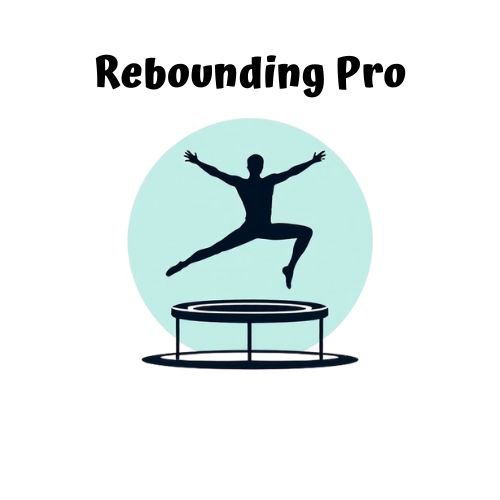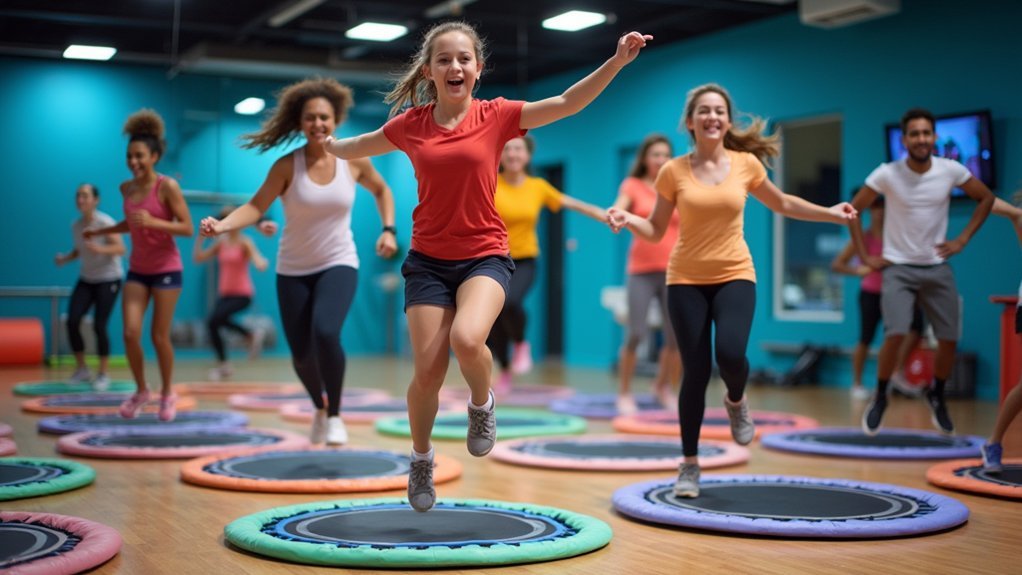Rebounding offers gentle yet effective workouts for beginners with minimal joint stress. Start with the health bounce, keeping feet hip-width apart and knees slightly bent. Progress to simple movements like heel lifts, side steps, and seated exercises for core strengthening. Add upper body conditioning with light dumbbells while bouncing. Incorporate mindful breathing to reduce stress and improve focus. Your confidence will build as you discover how these zero-impact routines transform both body and mind.
Gentle Bounce Foundations: Getting Started on Your Rebounder

While traditional exercise can strain joints and discourage beginners, rebounding offers a gentler alternative that’s perfect for those just starting their fitness journey.
Begin by standing with feet slightly wider than hip-width, knees softly bent, and core engaged by drawing your navel toward your spine.
Perfect posture powers your rebounding practice—stand wide, bend knees slightly, and activate your core for maximum benefit.
Start with a health bounce—barely lifting your feet off the mat—to stimulate circulation. Add gentle variations like heel lifts or side-to-side shifts to build stability. Incorporating dynamic stretches while on the trampoline can enhance your mobility and prevent injuries. Focus on pressing downward rather than jumping high, and keep your eyes fixed on a point ahead for balance.
Maintain proper posture with shoulders relaxed and spine neutral.
Begin with just 5-10 minutes of consistent, controlled movements, gradually increasing duration as your confidence grows. Remember, it’s about gentle bouncing, not height or intensity.
The Health Bounce: Mastering the Essential Zero-Impact Movement
The Health Bounce forms the foundation of all rebounder exercises, serving as your gateway to zero-impact fitness. This technique involves pushing your heels down into the trampoline surface while keeping your core engaged, effectively activating your glutes and stabilizing muscles.
Begin with the Bounce Down movement, focusing on controlled pressure rather than height. If you’re just starting out, try No-Jump Walking in place to build confidence. As you progress, incorporate Side Steps and Heel Taps to enhance coordination and balance. Remember to position your feet wider than hips with a slight knee bend for optimal stability and form.
Remember to maintain a tight core throughout each movement—this maximizes effectiveness while protecting your spine.
You can modify these exercises by reducing your range of motion or slowing your pace. For added stability, stagger your feet or use your arms as counterweights while you master these fundamental movements.
Lymphatic Flush Routine: Boosting Immune Function Without Strain

Designed specifically for rebounding beginners, the Lymphatic Flush Routine targets your body’s waste removal system without placing strain on joints or muscles. This gentle sequence stimulates detoxification while improving circulation throughout your body.
Start with light bouncing for 2-3 minutes to prepare your lymphatic system. Then incorporate gentle arm movements, raising them overhead and lowering them while maintaining a steady bounce.
Focus on the major lymph areas—neck, armpits, and groin—by lightly tapping these regions during your bounce. This technique effectively pushes excess fluid toward lymph nodes, similar to traditional lymphatic drainage massage.
The routine works by creating a pumping action that helps move stagnant lymph fluid toward drainage points. You’ll likely notice reduced puffiness, increased energy, and improved skin tone.
For enhanced benefits, combine with deep breathing exercises and stay hydrated before and after your session.
Core Stability Series: Building Strength While Protecting Your Joints
Developing a strong core remains essential for trampoline fitness success, even in zero-impact workouts. Start by engaging your abdominal muscles with a gentle squeeze while maintaining a micro-bend in your knees to reduce joint strain.
Position your feet shoulder-width apart with full-foot contact on the mat. This symmetrical stance distributes pressure evenly and improves balance. For beginners, it’s best to maintain an athletic stance with hips pushed back and chest forward while performing any trampoline exercise.
Begin with slow, controlled movements close to the mat, focusing on a heel-driving motion rather than high jumps. Incorporate arm movements like swings and shoulder rolls to enhance core engagement while maintaining proper alignment.
Try resistance-based exercises with tiny bounces and pulsing motions that create a weightless sensation in your upper body. If you’re feeling unsteady, don’t hesitate to use a stability bar for support or modify with stepping motions instead of bounces.
Seated Rebound Exercises: Perfect for Limited Mobility

Seated rebounding offers you a gentle pathway to fitness with the simple chair bounce technique that protects vulnerable joints while still delivering cardiovascular benefits.
You’ll strengthen your upper body by incorporating arm movements like lateral raises and chest presses during your seated sessions.
Your core muscles won’t miss out either, as you can engage them through controlled twisting motions and deliberate posture adjustments while remaining comfortably seated on the trampoline. This exercise is especially valuable for seniors since it provides a low-impact workout that’s gentler on aging joints compared to traditional exercises while still building strength and mobility.
Chair Bounce Basics
While traditional exercise routines can be challenging for those with mobility issues, chair bounce workouts offer an accessible gateway to trampoline fitness.
You’ll perform these exercises seated on a mini-trampoline with your feet flat on the floor for stability. The gentle up-and-down motion engages your core muscles without the impact of standing exercises.
You’ll activate your proprioceptive system for better balance while protecting your joints from strain. For proper technique, maintain good posture and start with controlled movements. This approach provides low-impact exercise benefits, making it particularly suitable for seniors with arthritis or joint concerns.
Try simple bounces, seated marching, torso twists, arm movements, and leg extensions to develop a complete workout. Begin with 5-minute sessions several times weekly, gradually increasing duration as your strength improves.
Always use a sturdy chair or specialized rebounder seat for safety.
Upper Body Strengthening
For those with limited mobility, upper body strengthening can still be achieved effectively through seated rebound exercises on a mini-trampoline. The rebounder’s cushioned surface reduces joint strain while engaging stabilizer muscles in your upper body.
Try seated dumbbell exercises like hammer curls evolving into shoulder presses. Start with light weights, performing 15+ controlled repetitions while maintaining proper posture. You’ll feel your biceps, shoulders, and back muscles activating with each movement.
Incorporate core-engaging elements by adding knee lifts while holding weights overhead or performing seated pec flies with weights held above the chest for enhanced upper body development. You’ll feel your core-engaging elements by adding knee lifts while holding weights overhead or performing side twists with punches to work obliques and shoulders simultaneously.
For back strength, try seated rows or pullovers while leaning slightly back on the rebounder.
Remember to breathe through your nose and keep movements deliberate to maximize benefits while minimizing strain.
Core While Seated
The gentle bounce of a mini-trampoline creates an ideal foundation for strengthening your core muscles, even when limited mobility prevents traditional standing exercises.
Seated rebounding activates abdominal and lower back muscles without straining joints or risking falls.
Try these effective seated exercises: perform gentle bounces while contracting your core, incorporate torso twists to engage obliques, or practice seated marching to stimulate hip flexors.
Always maintain proper posture and breathe deeply throughout your routine.
Start with 5-10 minute sessions three times weekly, gradually increasing duration as your strength improves.
The consistency of your rebounding routine can lead to a stronger body over time, making daily activities easier to perform.
Use support handles or place a sturdy chair on the rebounder for added stability.
These low-impact movements not only improve core strength but also enhance balance, reduce joint pain, and boost cardiovascular health—all while protecting your body from high-impact strain.
Balance-Building Bounce Sequence for Beginners
You’ll build better balance on your mini-trampoline by starting with a stable, wide stance before advancing to more dynamic movements.
Focus on engaging your core throughout each bounce to create a strong foundation for all rebounding exercises. Position your feet hip-width apart with a micro bend in your knees to maintain proper form during the health bounce, which serves as an excellent starting point for beginners.
As you progress, gradually narrow your stance and add gentle arm movements to challenge your stability while maintaining proper form.
Stable Stance Progression
Mastering a stable stance forms the cornerstone of effective trampoline workouts for beginners. Start with feet hip-width apart, creating a broad base on the mat while maintaining slightly bent knees to absorb impact.
Keep your core engaged by drawing your navel inward as you lean slightly forward at the waist. This position optimizes weight distribution during bounces and helps you maintain control. Begin with a gentle rock side to side in a wide stance to warm up your body and prepare for more challenging movements.
Progress gradually from basic health bounces (small movements with heels lifting slightly) to more dynamic movements like in-and-out foot patterns and controlled directional stepping. Remember to land softly with each movement.
If you’re feeling unsteady, reduce jump height or hold onto a stability bar. As your confidence grows, incorporate gentle arm movements to enhance balance while keeping your shoulders relaxed.
Core-Focused Rebounding Techniques
Building a strong core while maintaining balance represents the heart of effective trampoline workouts. Start by engaging your core muscles, pulling your navel toward your spine during all movements. These exercises are particularly effective because they provide low-impact alternatives for cardiovascular fitness while still offering substantial muscle engagement.
| Exercise | Core Benefit |
|---|---|
| Static knee lifts | Builds foundational stability |
| Marching with arm pumps | Enhances balance coordination |
| Bouncing arm raises | Activates upper and lower core |
| Seated partial squats | Engages deep core muscles |
Begin with small bounces while keeping feet flat and knees slightly bent. When marching, lift knees to hip height and synchronize with arm movements. For seated core work, lower into a partial squat and hold for 5 seconds, then incorporate heel lifts to challenge balance. Always maintain a neutral spine and breathe rhythmically to reduce strain during all exercises.
Upper Body Conditioning: Arms and Shoulders on the Rebounder
The rebounder transforms traditional arm and shoulder exercises into dynamic, multifaceted workouts that engage multiple muscle groups simultaneously.
Take traditional arm workouts to new heights—rebounding creates fluid resistance that activates your entire upper body ecosystem with each bounce.
You’ll benefit from combining gentle bouncing with light dumbbells for controlled resistance movements that target shoulders, biceps, and triceps without joint strain.
Try tricep kickbacks while maintaining your balance on the mat, focusing on proper elbow extension while minimizing shoulder movement.
For bicep conditioning, perform single-arm curls in a static standing position to improve unilateral strength and stability.
Coordinate arm swings with your bounce rhythm to enhance neuromuscular control and proprioception.
Exercises like the Surf Twist combine torso rotation with arm movements, activating your obliques while improving shoulder mobility.
Remember to maintain core engagement throughout these exercises—it’s essential for stability and maximizing upper body benefits.
Incorporate rear flies to strengthen your upper back by squeezing shoulder blades together, which helps improve posture and counteracts the effects of prolonged sitting.
Cardio Without the Impact: Heart-Healthy Bounce Patterns
When it comes to cardiovascular exercise, rebounding offers a uniquely effective alternative to high-impact activities without sacrificing heart health benefits. Your mini trampoline workout elevates heart rate and improves circulation while the unstable surface engages core muscles for better balance.
Start with the Health Bounce, pressing down without lifting your feet from the mat. Progress to marching in place, lifting knees high to gradually increase intensity. The Basic Bounce keeps your upper body level while engaging your lower body, and side-to-side steps add lateral movement variation. These exercises are particularly beneficial as they provide low-impact exercise that protects your joints while still delivering cardiovascular benefits.
For more challenge, try Jumping Jacks or Front-Back Bounces on the rebounder. Always keep knees slightly bent to reduce joint stress, and begin with a gentle warm-up of marches to prepare your body for sustained activity.
Progressive Five-Minute Routines for Rebounding Success
Kickstart your rebounding journey with ultra-short workouts that you’ll grow over time as your confidence builds.
Start by mastering the Health Bounce technique for just five minutes daily, ensuring proper form before adding complexity.
You’ll gradually expand your routine by incorporating new movements like twists and switches while extending your sessions to 10 minutes after the first week. As you progress, try adding low-impact exercises like Scissors and Side to Side movements to enhance coordination and engage your core muscles.
Start Small, Build Confidence
Beginning your rebounding journey doesn’t require intense, complex workouts that leave you breathless. Instead, focus on mastering five basic movements for one minute each: the gentle health bounce to activate circulation, in-and-out steps for lateral coordination, front-to-back switches for mobility, simple twists for rotational movement, and the “scare move” to improve dynamic balance.
Maintain a micro bend in your knees, engage your core by drawing your navel toward your spine, and distribute weight evenly across your feet. If balance is challenging, use a support bar initially but work toward independence. Remember to breathe and rest between changes.
This approach gradually strengthens your cardiovascular system, boosts lymphatic function, and builds neuromuscular coordination without stressing your joints—setting a foundation for more advanced rebounding workouts later. As you progress, incorporate shoulder rolls and head tilts to properly mobilize your upper body during warm-up sequences.
Day-By-Day Progression Plans
Now that you’ve mastered the fundamentals, let’s map out a structured five-day journey to build your rebounding skills systematically. This progression guarantees you’ll develop proper form while gradually increasing intensity.
| Day | Focus |
|---|---|
| 1 | Health bounces with micro-movements; emphasize proper breathing |
| 2 | Wider stance bouncing with arm movements; incorporate upbeat music |
| 3 | Shuffle footwork and twisting moves; introduce interval training |
| 4 | Short sprint intervals with varied bounce heights; maintain core engagement |
| 5 | Combination routines with high knees; celebrate your progress |
Each day builds upon previous skills while introducing new challenges. Start with just five minutes per session, gradually extending as your endurance improves. Remember to maintain deep, rhythmic breathing throughout and end each session with stretching to enhance flexibility and reduce muscle tension.
Mastering Basic Form First
While many beginners are enthusiastic to jump right into intense trampoline workouts, proper form serves as the foundation for all rebounding success.
Start with your feet wider than hip-width, pressing evenly through your entire foot while maintaining a slight knee bend to absorb impact.
Engage your core throughout every movement—this protects your lower back and maintains stability. Keep your head aligned over your hips and your chest proud.
Begin with a progressive five-minute routine that builds confidence: health bounces with soft knee bends (minute 1), in-and-out foot movements (minute 2), switches or marches (minute 3), gentle twists (minute 4), and “The Scare” with arm coordination (minute 5).
Remember to keep bounces low and controlled, gradually incorporating arm movements as your balance improves.
Mindful Movement: Combining Breath Work With Zero-Impact Bouncing
Changing from high-impact exercise to trampoline workouts offers a unique opportunity to integrate mindfulness with movement.
Begin by establishing deep, rhythmic breathing as you feel the mat’s gentle rebound beneath your feet.
Coordinate your breath with your bounces—inhale through your nose as you rise and exhale through your mouth as you land. This synergy activates your parasympathetic nervous system, reducing stress while maximizing lymphatic circulation.
Maintain proper posture with hips back, knees slightly bent, and core engaged to protect your lower back.
As you gain confidence, incorporate gentle arm movements timed with your breath patterns.
Start with slow, controlled bounces rather than height. This mindful approach not only enhances cardiovascular benefits but also improves balance and body awareness without straining your joints.
Frequently Asked Questions
Can I Use a Trampoline if I Have a Pacemaker?
Using a trampoline with a pacemaker isn’t generally recommended. You’ll need your cardiologist’s approval, especially during the healing phase. If permitted, you should stick to gentle bouncing and avoid high-impact movements.
What Shoes Are Best for Rebounding Workouts?
For rebounding workouts, you’ll get the best results with cross-training shoes or flat-soled athletic footwear. They provide excellent support and grip without damaging the trampoline. Grip socks are a good alternative for more natural movement.
How Do I Clean and Maintain My Mini-Trampoline?
Clean your mini-trampoline monthly with mild soap and water. Wipe the mat and frame with a soft brush, rinse thoroughly, and let it dry completely. Check springs and bolts regularly, tightening as needed.
Can I Use a Rebounder During Pregnancy?
While you can use a rebounder during pregnancy, always consult your healthcare provider first. Stick to gentle bouncing where your feet don’t leave the mat and use a handlebar for balance and safety.
Will Rebounding Help With Specific Conditions Like Vertigo?
Rebounding might help with vertigo, but it’s a double-edged sword. You’ll need to start cautiously as the vestibular stimulation can improve balance long-term but might initially trigger symptoms. Consult your healthcare provider first.
In Summary
You’ve now discovered ten accessible rebounding workouts that won’t stress your joints. Start with just a few minutes daily and you’ll notice improved balance, energy, and lymphatic flow. Remember, consistency matters more than intensity when you’re beginning. Don’t worry about perfection—simply enjoy the gentle bounce and listen to your body. Soon you’ll be hooked on this fun, effective exercise that’s kind to your body.





Leave a Reply